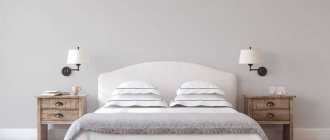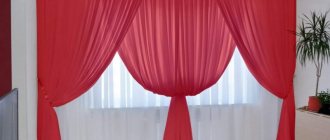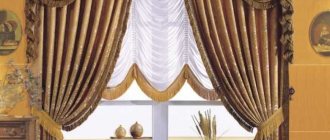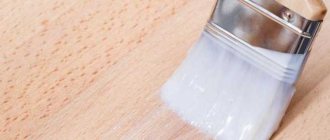The appearance and functionality of curtains depend not only on their quality and material, but also on the way they are attached above the window. In the vast majority of cases, they are attached to a ceiling or wall cornice. This method is unrivaled and has no equivalent analogues. But there are several options for attaching curtains directly to the cornice. An incorrectly chosen fastening can negate the entire attractiveness of the curtains and disrupt the stylistic unity of the interior. Therefore, before you go to the store for the curtains you like, you should decide exactly how they will be mounted on the curtain rod.
Curtains with ties
Ties look great on all types of fabric curtains with the exception of Japanese and French. For the former, they are too playful and romantic, while the design of the latter is too saturated with scallops, and such fastenings will overload their appearance.
Curtains with ties add a touch of romance, lightness and airiness to the decor
You can make ties from anything: ribbons, braid, cords. Everything depends only on the taste and imagination of the designer. They are tied into knots or bows. It should be taken into account that for curtains made from dense and heavy fabric, the ties should be stronger and thicker than for curtains and tulle. Otherwise, they will not support their weight and will quickly tear.
Most often, the ties are sewn from the same fabric as the curtains themselves.
The photo shows a curtain set in which the ties and tiebacks for curtains are made of the same material as the curtains
An interesting idea: ties and tiebacks, sewn from fabric contrasting with the curtains
How to hang curtains with your own hands
There are several options for hanging curtains. But before you get down to business, you need to take a few more actions that are important for the result.
Mount selection
First of all, you need to know what curtains are hung on. The choice of fastening largely depends on the type of curtains, cornice and tastes of the owner.
Fastening elements are placed on the cornice.
Fastenings are selected depending on the type of cornice structure. But there are a number of general guidelines to follow:
- Consider how to install the cornice during the renovation stage.
- Plastic fasteners are not suitable for hanging heavy curtains, as they can bend under their weight and become deformed. You need to choose stronger metal products.
- The cornice must match the color of the furniture or flooring. As a rule, eyelets, drawstrings, loops or clips are attached to it. If the ceiling is low, then it is better to mount the cornice in close proximity to the ceiling, and use hooks on rollers to secure it.
- The way the curtains are hung should be consistent with the design of the entire room.
There are many ways to attach a cornice to a wall.
The types of fastenings are discussed in this article below.
Choosing a cornice
When entering any room, the eye falls on the window, and how it looks affects the overall perception of the room. It immediately catches your eye if the cornice does not match the surrounding environment, especially for curtains and wallpaper. For this reason, before you start choosing a design, you need to decide at least on the color scheme of the room and determine the dominant material: metal, wood or plastic.
The range of curtain rods from various manufacturers is more than wide.
Cornices can be wall or ceiling. A product of the first type can be selected to match any design and even make the window a special area that will set the tone for the entire room.
The cornice can be attached to the wall and ceiling.
Ceiling products allow you to cover the window and wall from floor to ceiling. The material from which the cornice is made matters both in terms of appearance and structural reliability. Wood products will look more expensive and noble, but low-quality designs will quickly deform, especially under the weight of heavy curtains.
For a high-quality cornice, it is better to choose steel rather than plastic.
Plastic curtain rods are not the most reliable, but they have many design options. Metal products are the most reliable and profitable, and they look attractive in any interior.
The cornice must match the design of the window.
It is also worth paying attention to the types of cornices in appearance and structure:
- Round - there are single-row, double-row and three-row depending on how many layers of fabric you plan to hang.
- Strings are similar to round ones. The design is a tightly stretched string. They are simple and original and look great in any interior.
- Baguette cornices fit classic or European style. As a rule, they are either made of wood and decorated with beautiful carvings, or stylized as wood.
- Profile - do not serve as a decorative item: the entire structure is hidden under a curtain.
- Bay windows - needed for hanging curtains not in a straight line, but at an angle.
There are many types of cornices.
Curtains with hinges
Curtains with hinges look appropriate and harmonious in both strict classical and avant-garde interior styles and in rooms of any functional purpose. The loops are suitable for all types of curtains. Such fastening can be found even on Japanese and Roman models.
Loops can be simple or decorated with curtain accessories, statically sewn or fastened with buttons, snaps or velcro tape
Like ties, loops can be made from any available textile materials: ribbons, braids, ropes, cords. But most often they are sewn from the same fabric as the curtains or from a companion fabric. It is very convenient to use this mount. To hang curtains, simply thread the curtain rod through the loops.
Strict loops, sewn from the same fabric as the drapes and curtains, emphasize the beauty of the deep flowing folds on the curtains
Hinged curtains look especially good on thin round curtain rods
Multi-colored fun loops on buttons and funny toy tiebacks in this photo dilute the monochrome of plain curtains the color of baked milk and are ideal for a window in a nursery
What to look for when choosing?
The main criterion when choosing an option for attaching textile fabric is the type of cornice itself. Modern devices with hooks in the runners allow only one type of hanging of curtains: on curtain tape. But old-style curtains, with 1-2 rods on brackets, allow you to use curtains with rings, eyelets, and many other interesting solutions.
In addition to the type of cornice, attention is also paid to the structure of the material from which it is planned to sew the curtains. For thick curtains, it is better to choose the classic version with rings. This method will help create smooth folds and make closing curtains easier to move.
Particular attention is paid to the style of home decoration:
- For interiors in non-classical but strict styles (for example, minimalism), thick curtains can be made with eyelets. Correctly installed rings will help you easily form uniform, uniform folds. Most often, thin tulle items are hung on eyelets.
- For styles that allow the use of lambrequins (classic, Victorian, etc.), it is better to choose a ceiling cornice with hooks and hang 2-3 layers of textiles on the curtain tape. You can attach the lambrequin to the ceiling cornice using Velcro tape (Velcro), gluing 1 part of it to the front panel of the cornice.
- In Provence, country style rooms and other simple interiors, fastening options such as a drawstring or ties on the upper border of the canvas are appropriate. There are many design options for such products: from naive bows to stylish and laconic flaps with buttons or buttons.
Curtains with eyelets
Curtains with eyelets are considered one of the most versatile and stylistically thoughtful design options for window and door openings. Eyelets are metal, plastic or wooden rings that frame holes in the upper part of drapes or curtains through which the round cornice pipe is threaded. In this case, the hole itself is almost invisible and it seems that the cornice passes directly through the fabric.
Curtains with eyelets are characterized by noble, laconic simplicity and the emphasis in their design is on the texture and color of the fabric.
Curtains with eyelets look best in classic, not too romantic or modern, but quite austere interiors. They are distinguished by smooth, deep folds and do not require voluminous draperies or additional details in the form of swags and lambrequins.
Eyelets are equally good for plain and printed curtains
When the eyelets are matched to the curtains, it seems that the cornice is piercing the fabric. It looks very impressive
Eyelets can not only be strung on a cornice, but also loops can be threaded through them, as on the Japanese curtain in this photo
Hooks
Curtain hooks are a popular and in many cases the most convenient type of fastening.
Curtains with hooks are the most budget-friendly of all possible methods. Hooks are ideal for attaching curtains to a flat curtain rod. When choosing this option, you need to check for the presence of latches to prevent slipping.
Hooks hold the fabric well and are suitable for almost any type of curtains, except heavy drapes
So, the main advantages of this option:
- easy installation;
- cheapness;
- They hold any fabric perfectly (with the exception of heavy curtains).
This type of mount does not look particularly aesthetically pleasing. However, if the emphasis is on cheapness, simplicity and ease of installation, then hooks are the ideal choice.
Hooks are also the cheapest type of fastening
Drawstring curtains
Drawstring curtains are a type of straight curtains or drapes. They differ from other models by the presence of a tunnel pocket in the upper part. In order to hang such curtains over a window, a round rod or string of a string cornice must be passed through a pocket (drawstring).
This mount is easy to make yourself, and it looks cute and simple.
Drawstring curtains are unlikely to be appropriate in strict and prim interiors, but they will fit perfectly into romantic or “rustic” interior styles, such as shabby chic, Provence, Mediterranean, ethnic, and country. In addition, the drawstring is one of the few fastenings that is perfect for curtains hung on attic and arched windows, as well as for cafe-style curtains.
For light short kitchen curtains, drawstring can be the ideal solution
Due to the way they are fastened, the folds on such curtains are always frequent and small, which looks especially good in a romantic and delicate setting.
Drawstring curtains fit perfectly into all “rustic” interiors: American country, English shabby chic and French Provence, as in this photo
Types of fastening without cornice
- Universal fastenings for sashes (brackets). Compact fastening element, used for placing roller and pleated curtains, as well as horizontal blinds.
- Velcro. This method does not require a gap between the curtain and the wall. Suitable for rooms where complete darkness is required.
- Using self-tapping screws. Universal and simple installation method.
- Double sided tape. A practical, handy way to hang fabric and other fabrics on a window sash without drilling. Not reliable enough and unable to withstand heavy loads.
Curtains with braid
Curtains with braid (curtain tape) are an excellent option for those who, without professional experience, dream of sewing magnificent curtains with complex folds with their own hands. Such fastenings are suitable for both profile and round cornices, including those with a set of rings. Curtain braid is sold in all haberdashery stores.
The principle of operation of curtain tape is that by stretching cords along its entire length, folds of any frequency and depth can be formed on the curtains
Using braid, you can assemble curtains into even and deep folds, simulating manual gathering or small and frequent pleats made by machine. The former look best on thick curtain fabrics, the latter on curtain fabric or light silk. Curtains with braid are appropriate in any interior and, despite the fact that they look quite self-sufficient and decorative, they are often combined with lambrequins, curtains and swags.
Any cornice is suitable for such fastening: round (as in the photo), profile, string, and its choice depends only on the interior concept
Using curtain tape it is very convenient to form frequent small folds on the fabric
Extraordinarily elegant curtains, gathered with braid into complex triple pleats in the shape of cups
In this photo of the curtain the cornice is almost invisible. Curtains with braid seem to float in the air and look very impressive
How to decorate custom windows?
For windows of complex shape, inclined attic, panoramic openings, you can choose suitable curtain options:
- roller blinds that can be glued directly above the glass, covering only it;
- Pleated blinds are also suitable for triangular openings; they can be fixed in the middle of the window or at the bottom of it;
- hourglass curtains do not open, and are made of transparent fabrics, securing both the bottom and top of the product directly next to the glass;
- for an arched window, a profile cornice with any type of curtains is suitable;
- in a bay window, the same profile can be conveniently installed around the perimeter of the room on the wall or ceiling.
Framing a non-standard window can also be done using simple curtains, attaching curtains to ceiling cornices, or using a rod, installing it below the upper, shaped border of the opening.
Curtains with hooks, clips and clothespins
Curtains with hooks and clips (clothespins, crocodile clips) are perhaps the most traditional and familiar to us. Previously, such fastenings were made only of metal. Today they are also made from durable flexible plastic. The principle of operation of all these fasteners is the same. On rings or metal or plastic loops that are strung on a round or string cornice, clothespins, hooks or magnets are fixed, which hold the curtains on the cornice.
Such fastenings can be almost invisible, or can act as an independent decorative element
Recently, magnetic clamps have also become very popular. They look very decorative, do not require loops or curtain tape, like hooks, and with them there is no risk of putting a tie on the fabric, which quite often happens when attaching curtains with clothespins. The design of all types of such mounts is very diverse. Therefore, you can always choose a suitable option for any interior style.
Rings are constant companions of round cornices. Such traditional fastenings are ideal for classic interiors
Sometimes for such fastenings a cornice is not needed at all: just hammer a few decorative nails into the wall
To form even and symmetrical folds, the hooks are placed at the same distance from each other
Curtain fastenings “crocodiles” got their name due to their appearance, vaguely reminiscent of the mouth of the reptile of the same name. They are metal or plastic clothespins with teeth that provide a tight and fairly strong grip. The clothespins are attached to the round cornices using the rings that come with them.
Crocodiles were popular with our grandmothers and are rightfully considered veterans among curtain mounts
Such clips are distinguished by their fixation, which does not require additional holes or loops, are convenient and easy to use and make it possible to adjust the length of the curtain at your discretion (the fabric does not need to be cut, but simply fold it at the top), as well as the frequency and depth of the folds. In addition, they are able to hold a lot of weight and can be used on curtains made of thick, heavy fabric. The only drawback of clips with sharp teeth is that a crocodile clip can leave puffs on the fabric or pinch the skin on your hands. To prevent this from happening, you need to use them carefully, and draw and open the curtains smoothly, without sudden movements.
To find out how many clothespins you will need for a particular curtain, you need to divide its width by the step between the clips and add one.
The depth of the folds depends on the pattern of fastening the crocodiles on the curtains and their number. The more often the clothespins are attached, the smaller they are, and vice versa, the greater the distance between the clips, the deeper and more expressive they are. For example, by installing clothespins every 10 cm, you will get folds 5 cm deep, every 15 cm ─ 7.5 cm.
In order to form even and symmetrical folds, a very simple technique is used. The curtain is folded in half widthwise and 3 crocodiles are attached to it (or the places where they will be attached with tailor’s chalk are marked) ─ one in the middle, two at the edges. Then each half is folded in half again and the crocodile is secured at the fold. These actions continue until the clothespins run out.
Clothes pins “Cylinder” and “Cobra” clips are popular new items on the market
Recently, “Cobra” and “Cylinder” clamps have appeared on sale. They work on the same principle as alligator clips, but due to the absence of teeth they have a more gentle fixation. Such clips are guaranteed not to leave puffs on the curtains, look very creative, but are not suitable for heavy fabrics and are used only on light curtains and curtains made of tulle, organza and veil.
We have listed only the main methods of attaching curtains to a curtain rod. Almost all of them can be combined with each other, making interesting and original combinations. For example, eyelets do not have to be strung on a cornice. You can pass ribbons or strings through them and tie them on a barbell, adding a romantic touch to the formal eyelets. The alternation of ties and loops on one curtain also looks non-trivial. There are a lot of options, and their choice depends only on the designer’s imagination.
How to beautifully drape a panel?
In order for the curtain panels to form beautiful folds, you need to know how to properly hang the curtains on the cornice. The stick and string devices have rings and clips for this purpose, and the profile one is equipped with hooks. The curtains are attached to the curtain rods using these elements: the hooks can be inserted into the loops, and the clips and rings are equipped with clamps.
But in order for the curtain to lie in even waves, it is not enough to simply attach it to the cornice. Folds need to be laid either when sewing or when hanging curtains from the ceiling. In order to make a wave or gather when sewing, take 1.5-2 times more material than required by width measurements. You can make drapery when sewing like this:
- Sew curtain braid to the wrong side of the panel. It consists of a fabric tape through which strong threads are pulled. The sewn braid needs to be collected by pulling out these threads. As a result, the canvas will acquire a neat gather along the upper edge and form lush small folds.
- On the fabric, mark places for folds (counter, bow, one-sided), fold the material as required for this, and stitch it.
To hang draped curtains, you can use any type of fastener.
Folds on tulle
When hanging curtains with a straight panel, proceed differently. There is an old way to hang tulle to make the curtain look fuller. This requires an odd number of rings on the cornice. First, the tulle must be attached along the edges with 2 rings on the left and right. In this case, the sides are turned towards the window by 5-7 cm and 2 layers of fabric are clamped with a clip at once. Next you need to disassemble the rings into 2 sides. There will be 1 ring left in the center.
Find the middle of the curtain, make a small fold and secure it with a clip. On each half of the panel, do the same steps: disassemble the rings, find the center, secure with a fold. Do this until the entire top of the curtain is folded. Then stretch the tulle along the cornice.











